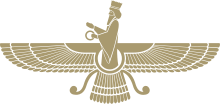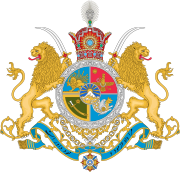Faravahar


| Part of a series on |
| Zoroastrianism |
|---|
 |
|
|
The Farāvahār (Avestan: 𐬟𐬀𐬭𐬎𐬎𐬀𐬵𐬀𐬭𐬀; Persian: فَرْوَهَر), also called the Foruhār (فروهر) or the Fārre Kiyâni (فرّ کیانی),[1] is one of the most prominent symbols of Zoroastrianism. There is no universal consensus on what it means or stands for, as a variety of interpretations exist. The most common belief is that it depicts the fravaṣ̌i (𐬟𐬭𐬀𐬎𐬎𐬀𐬴𐬌), which is the Zoroastrian concept of the monotheistic god in Zoroastrianism.[2][3]
Rooted in ancient Near Eastern tradition, the Faravahar was especially prevalent in the Achaemenid Empire, correspondingly appearing in many works of Achaemenid architecture. Although it is originally religious in nature, it has become a secular and cultural symbol among non-Zoroastrian Iranian peoples (including Persians, Kurds and Tajiks), having been popularized in this capacity after the Muslim conquest of Persia and the subsequent fall of Sasanian Empire.[4][5]
More recently, the Faravahar and other aspects of the Zoroastrian religion were at the forefront of a campaign by the Pahlavi dynasty to revive the pre-Islamic Iranian identity. Since the Islamic Revolution in 1979, it has remained a popular symbol among both Iranians inside of Iran and the Iranian diaspora.
Etymology
[edit]The New Persian word فروهر is read as foruhar or faravahar (pronounced as furōhar or furūhar in Classical Persian). The Middle Persian forms were frawahr (Book Pahlavi: plwʾhl, Manichaean: prwhr), frōhar (recorded in Pazend as 𐬟𐬭𐬋𐬵𐬀𐬭; it is a later form of the previous form), and fraward (Book Pahlavi: plwlt', Manichaean: frwrd), which was directly from Old Persian *fravarti-.[2][6] The Avestan language form was fravaṣ̌i (𐬟𐬭𐬀𐬎𐬎𐬀𐬴𐬌).
Symbolic meaning of the Faravahar
[edit]The Faravahar (or Farvahar) is a significant symbol in Zoroastrianism that conveys deep spiritual and moral meaning. Its elements are interpreted as follows:
- Human Figure: Represents the soul and human wisdom, symbolizing an individual's choice to follow the righteous path in life.[7]
- Wings: Composed of three rows of feathers, each row stands for the core Zoroastrian principles of Good Thoughts, Good Words, and Good Deeds.[8]
- Tail Feathers: Divided into three sections, these signify Bad Thoughts, Bad Words, and Bad Deeds, highlighting what should be avoided to lead a virtuous life.[9]
- Two Streamers: Extending from the central circle, these symbolize the duality of existence: good and evil. The right-hand streamer represents good, while the left-hand streamer points to evil, emphasizing the importance of choosing the right path.[10]
- Circle in the Middle: Signifies the eternal nature of the universe and the soul, representing the cyclical essence of life.[11]
- Ring in the Figure's Hand: Often interpreted as a ring of covenant or loyalty, it symbolizes a commitment to righteousness.[12]
- Head Facing Forward: Indicates progress and the continual pursuit of growth and improvement.[13]
The Faravahar embodies moral integrity, spiritual progression, and the concept of choosing good over evil, encouraging individuals to live by the principles of wisdom and virtue.[14]
History
[edit]
Ancient Near Eastern religion
[edit]The pre-Zoroastrian use of the symbol originates as the winged sun used by various powers of the Ancient Near East, primarily those of Ancient Egypt and Mesopotamia. The Zoroastrian adoption of the symbol comes from its prevalence in Neo-Assyrian iconography. This Assyrian image often includes their Tree of Life, which includes the god Ashur on a winged disk.[15]
Zoroastrian tradition
[edit]
The faravahar was depicted on the tombs of Achaemenid kings, such as Darius the Great (r. 522–486 BC) and Artaxerxes III (r. 358–338 BC).[16] The symbol was also used on some of the coin mints of the frataraka of Persis in the late 3rd and early 2nd BC centuries.[17] Even after the Arab conquest of Iran, Zoroastrianism continued to be part of Iranian culture. Throughout the year, festivities are celebrated such as Nowruz, Mehregan, and Chaharshanbe Suri which relate to Zoroastrian festivals and calendar. These are remnants of Zoroastrian traditions. From the start of the 20th century, the faravahar icon found itself in public places and became a known icon among Iranians. The Shahnameh by Ferdowsi is Iran's national epic and contains stories (partly historical and partly mythical) from pre-Islamic Zoroastrian times. The tomb of Ferdowsi (built early 1930), which is visited by numerous Iranians every year, contains the faravahar icon as well.[18]
Whilst being used by both modern day Zoroastrians and Persians, it is important to note the symbol is neither Zoroastrian nor Persian in its origin. It originates as a Mesopotamian Assyrian depiction of the wing deity Ashur. After the Achaemenian dynasty, the image of the farohar was no longer[citation needed] present in Persian art or architecture. The Parthians, Sassanians and Islamic kings that followed did not use the image. It was not until the 20th century,[citation needed] over 2000 years later,[citation needed] that the symbol re-emerged thanks to the work of Parsi scholar, Jamshedji Maneckji Unvala, who published two articles in 1925 and 1930.[19][20]
Unvala's work was discredited by Irach Jehangir Sorabji Taraporewala, who refuted the idea that the winged figure represented Ahura Mazda. Taraporewala suggested that the figures used in Persian reliefs were meant to depict khvarenah or royal glory to reflect the perceived divine empowerment of kings, and, therefore, has no true spiritual meaning. This view was later supported by Alireza Shapour Shahbazi and Mary Boyce.[21][22][23]
Modern pan-Iranian usage
[edit]The Sun Throne, the imperial seat of Iran, has visual implications of the Faravahar. The sovereign would be seated in the middle of the throne, which is shaped like a platform or bed that is raised from the ground. This religious-cultural symbol was adapted by the Pahlavi dynasty to represent the Iranian nation.[24] In modern Zoroastrianism, one of the interpretations of the faravahar is that it is a representation of the human soul and its development along with a visual guide of good conduct.[25] Another popular interpretation is that it is a visual representation of a Fravashi, though Fravashis are described in Zoroastrian literature as being feminine.[2] One of the most prevalent views in academia as to the meaning of the faravahar is that it represents Khvarenah, the divine power and royal glory.[2] Although there are a number of interpretations of the individual elements of the symbol, most are recent interpretations and there is still debate as to its meaning.
After the Islamic Revolution of 1979, the Lion and Sun, which was part of Iran's original national flag, was banned by the government from public places. Nevertheless, faravahar icons were not removed and as a result, the faravahar icon became a national symbol for Iranians, and it became tolerated by the government as opposed to the Lion and Sun.[26] The winged disc has a long history in the art, religion, and culture of the ancient Near and Middle East, being about 4000 years old in usage and noted as also symbolizing Ashur, Shamash, and other deities.[25]
Gallery
[edit]-
Achaemenid cylinder seal from the city of Hillah
-
Zoroastrian tomb in the city of Sulaymaniyah
-
Stone-carved pillar in the city of Persepolis
-
Top of the Tomb of Ferdowsi in the city of Mashhad
-
Entrance of the National Bank of Iran in the city of Tehran (1946)
-
Top of the Fire Temple of Yazd
-
Coat of Arms of the Imperial State of Iran, prior to the Islamic Revolution of 1979
-
Stone-carved artifact in the city of Persepolis
-
Museum of Zoroastrians at the Fire Temple of Kerman
-
The Suez Inscriptions at the Canal of the Pharaohs in Wadi Tumilat, written by Darius the Great in Persian, Elamite, Akkadian, and Egyptian
-
Stone-carved wall depicting Persians and Medes of the Achaemenid army under the Faravahar at the Apadana Hall in the city of Persepolis
Citations
[edit]- ^ book_rahnamaye_TakhteJamshid. Author: Shahpoor Shahbazi
- ^ a b c d Boyce 2000, pp. 195–199.
- ^ "FRAVAŠI – Encyclopaedia Iranica". www.iranicaonline.org. Retrieved 4 April 2020.
- ^ "Europe | The Identity Necklace: Being Iranian in Britain". FRONTLINE - Tehran Bureau. Retrieved 4 April 2020.
- ^ Szanto, Edith (15 May 2018). ""Zoroaster was a Kurd!": Neo-Zoroastrianism among the Iraqi Kurds". Iran and the Caucasus. 22 (1): 96–110. doi:10.1163/1573384X-20180108. ISSN 1573-384X.
- ^ MacKenzie, David Neil (1986). A Concise Pahlavi Dictionary. London: Oxford University Press. ISBN 0-19-713559-5.
- ^ Boyce, Mary (1979). Zoroastrians: Their Religious Beliefs and Practices. Routledge. ISBN 978-0415239028.
- ^ Duchesne-Guillemin, Jacques (1966). Symbols and Values in Zoroastrianism. Psychology Press. ISBN 9780415376236.
{{cite book}}: Check|isbn=value: checksum (help) - ^ Gnoli, Gherardo (1985). "Zoroastrianism". Encyclopaedia Iranica.
- ^ Shahbazi, A. Shapur (1987). The History of the Idea of Dualism in Ancient Persia. Brill Academic Publishers. ISBN 9789004092950.
{{cite book}}: Check|isbn=value: checksum (help) - ^ "Faravahar Symbolism". Heritage Institute. Retrieved 3 November 2024.
- ^ Boyce, Mary (1982). A History of Zoroastrianism: Volume II. BRILL. ISBN 9789004065299.
{{cite book}}: Check|isbn=value: checksum (help) - ^ Eduljee, K. E. (2013). Zoroastrian Beliefs and Practices. Verlag nicht ermittelbar. ISBN 978-1445150903.
{{cite book}}: Check|isbn=value: checksum (help) - ^ "Faravahar – Symbol of Zoroastrianism". Zoroastrianism Facts. Retrieved 3 November 2024.
- ^ Parpola, Simo (July 1993). "The Assyrian Tree of Life: Tracing the Origins of Jewish Monotheism and Greek Philosophy" (PDF). The University of Chicago Press. 52 (3): 161–208. Retrieved 4 November 2020.
- ^ Olbrycht 2016, p. 93.
- ^ Olbrycht 2016, p. 94.
- ^ "FERDOWSI, ABU'L-QĀSEM iii. MAUSOLEUM – Encyclopaedia Iranica". www.iranicaonline.org. Retrieved 14 July 2019.
- ^ Unvala, Jamshedji Maneckji (1888-1961). (c. 1900). The winged disk and the winged human figure on ancient Persian monuments. s.n. OCLC 982616419.
{{cite book}}: CS1 maint: numeric names: authors list (link) - ^ Eduljee, K. E. (2013). Farohar / Fravahar motif: what does it represent? use of icons & symbols in Zoroastrism. [Verlag nicht ermittelbar]. OCLC 891516152.
- ^ Taraporewala, Irach Jehangir Sorabji (2006). The religion of Zarathushtra. Jain Pub. Co. ISBN 978-0-87573-092-9. OCLC 154674597.
- ^ Boyce (1 January 1982), A History of Zoroastrianism, Zoroastrianism under the Achaemenians, BRILL, pp. 104–, ISBN 978-90-04-29390-8
- ^ Shahbazi, A. S. 1974 An Achaemenid Symbol, I A Farewell To ' Fravahr' And ' Ahuramazda.' AMI 7 135 144.
- ^ "ZOROASTRIANS OF 19TH-CENTURY YAZD AND KERMAN – Encyclopaedia Iranica". www.iranicaonline.org. Retrieved 14 July 2019.
- ^ a b "What Does the Winged Symbol of Zoroastrianism Mean?". About.com Religion & Spirituality. Archived from the original on 19 April 2016. Retrieved 26 January 2017.
- ^ Najmabadi, Afsaneh (2005). Gender and sexual anxieties of Iranian Modernity. University of California Press. ISBN 0-520-24262-9.
General sources
[edit]- Boyce, M. (2000). "Fravaši". Encyclopaedia Iranica. Vol. X, Fasc. 2. pp. 195–199.
- Curtis, Vesta Sarkhosh (2007). "Religious iconography on ancient Iranian coins". Journal of Late Antiquity. London: 413–434.
- Olbrycht, Marek Jan (2016). "The Sacral Kingship of the early Arsacids. I. Fire Cult and Kingly Glory". Anabasis. Studia Classica et Orientalia: 91–106.
External links
[edit] Media related to Faravahar at Wikimedia Commons
Media related to Faravahar at Wikimedia Commons












